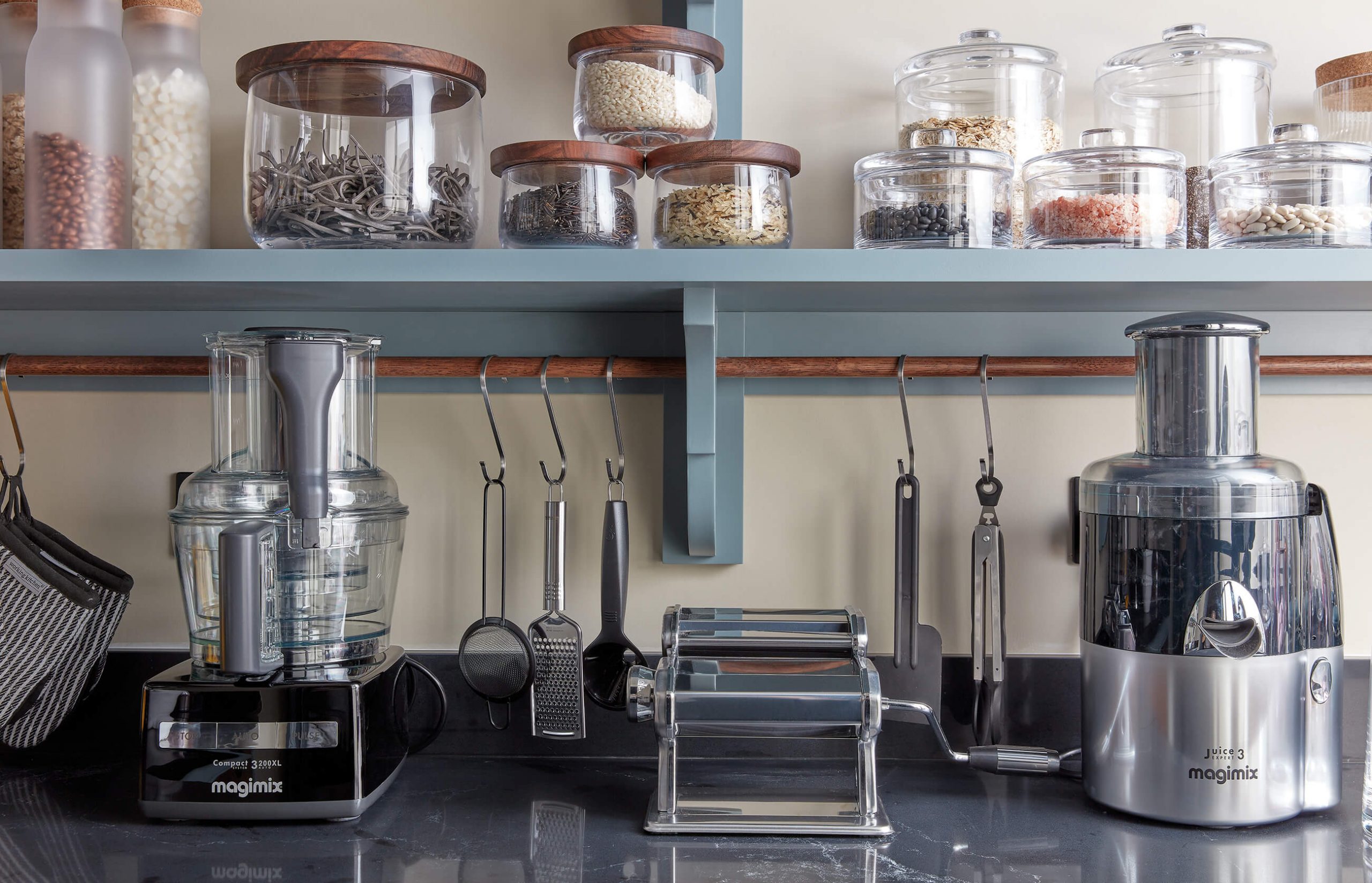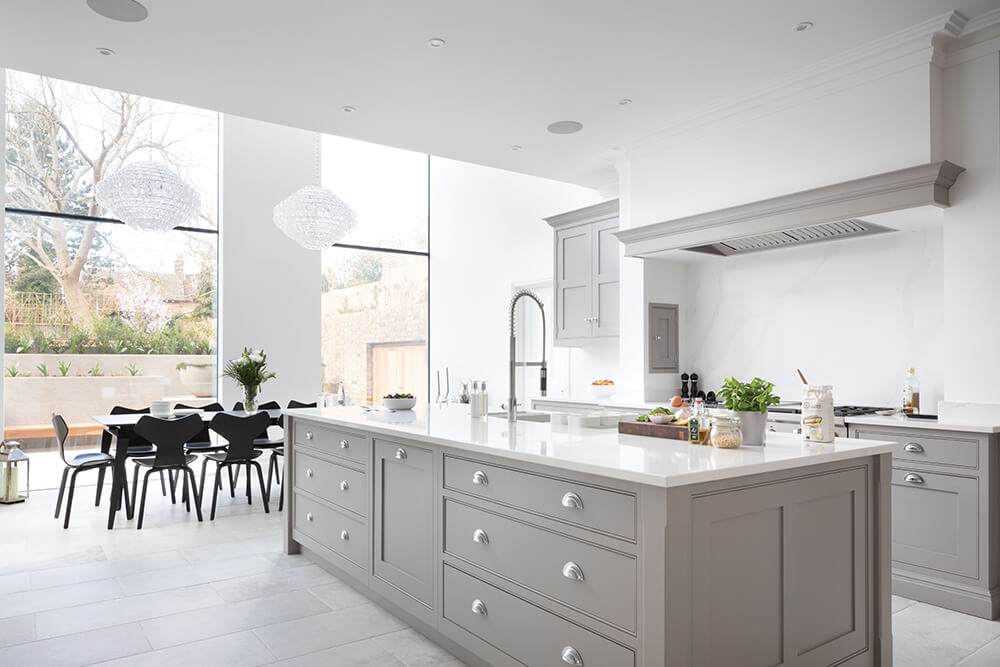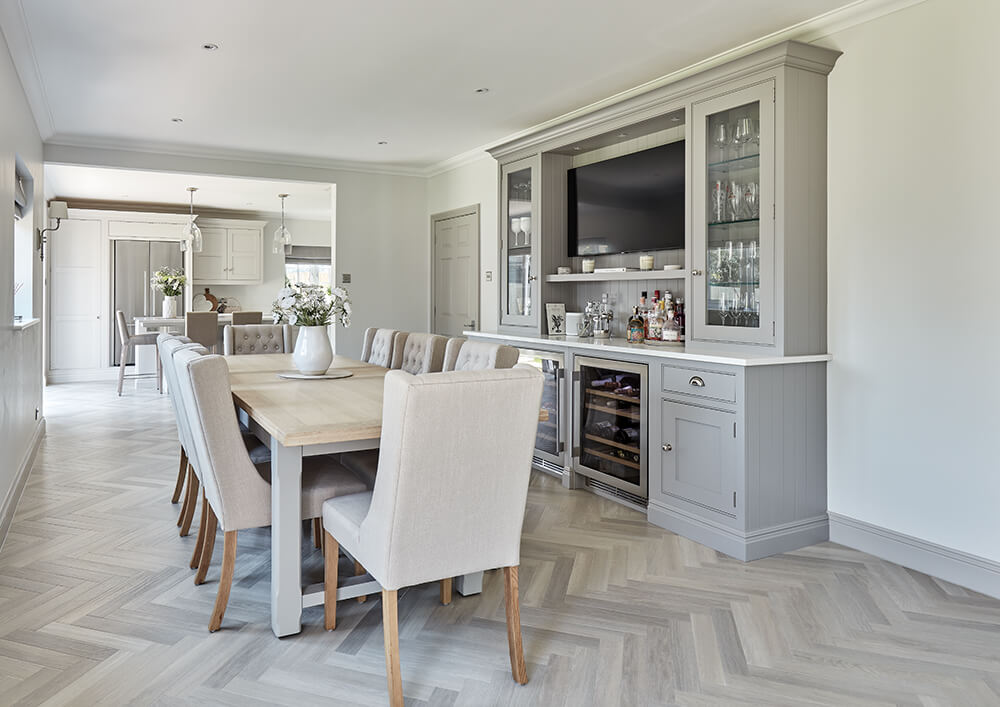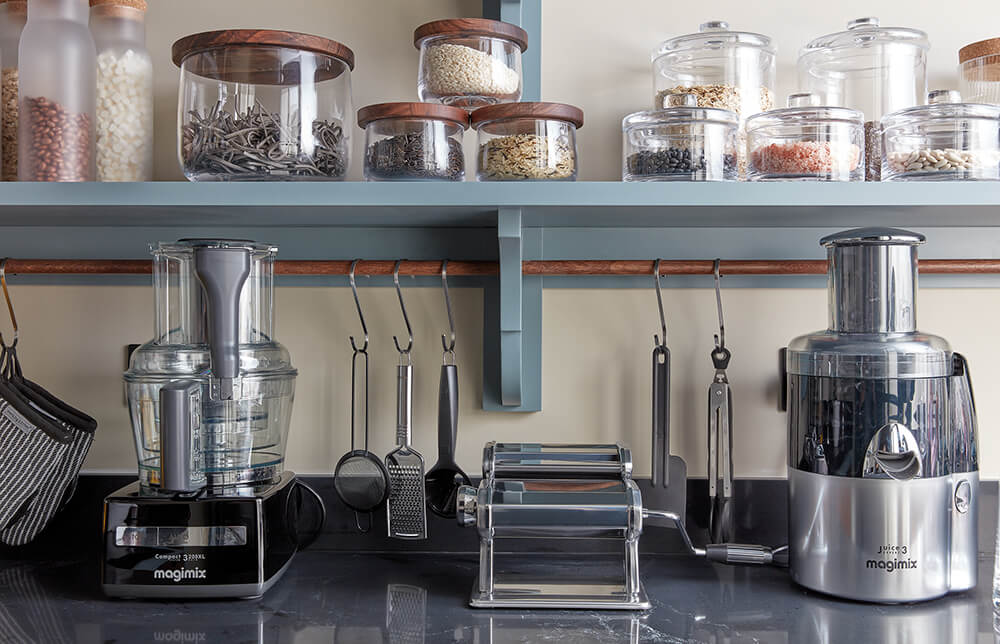

The kitchen is often the busiest room in the home, serving multiple functions throughout the day. No matter what size your kitchen is, it’s understandable that it can be challenging to keep it well-functioning, calm and clutter-free.
As the season for entertaining and baking is upon us, we’ve shared some of our secrets to creating a perfectly organised kitchen.

A regular seasonal reassessment and fairly ruthless clear out is essential in the kitchen. We can all be tempted by food bargains and beautiful kitchenware, which overwhelms our kitchen cabinets and worksurfaces. Filling your kitchen to the brim makes it difficult to see what you have, leading to wastage in the long run.
Clearing out your kitchen can be a daunting task. To make it easier, start with looking at one space at a time, visualising how you want each area to function. Once you have identified the key problem areas, make a manageable task list, ticking them off as you go.
Have a place for everything. Go through your kitchenalia, decide what you use regularly and which items are for occasional use, then store them accordingly — high shelves for hardly used items but everyday things at waist height.
We’re experts in turning chaotic family kitchens into organised homely hubs. When designing your dream storage, work out what’s important to you. If you’re a keen cook, plan storage around key elements such as the cooker, sink and fridge. If you love entertaining, think about displaying your glassware in a glazed dresser or incorporate storage for tableware and seasonal items that may only come out a few times a year.

When it comes to kitchen organisation, first, you should zone the space. Kitchen zones can include cooking, prep, entertaining, dining, consumables and cleaning. Having designated areas will allow you to store and organise items efficiently. Group similar items together. For example, tableware and glasses should be kept near your dining area. Similarly, essential food items, utensils and pans should be placed close to your cooker for easy access.
Ideally, work surfaces need to be kept as clear as possible for food preparation and effective cleaning. Reserve space for daily necessities such as your coffee machine, kettle and microwave. If you have room, a bi-fold pantry is a fantastic way to hide away these small appliances.
Although clear work surfaces are essential for a well-functioning kitchen, we still like to keep some key accessories and organic elements on display. A beautiful bowl with produce, statement vase with foliage or a luxurious soap dispenser next to your sink can add personality and warmth.
The breakfast pantry is perfectly designed for family living, allowing you to store your entire morning conveniently – from a professional coffee machine, Quooker tap, teas, bulky cereal boxes and storage for everyday crockery. The best thing is once you’ve had enough, you can close the doors behind you, concealing all of the clutter.
The items you use and the food you eat can vary with the seasons. Find areas where you can store away items that you only use in the heat of the summer months or at Christmas. Use higher shelves, storage in bespoke bench seating or within your kitchen island. You can swap items in and out each season, bringing your most used to the front for a more streamlined setup.
Decanting dried goods such as pasta, grains, and flour into containers is an excellent option if you have glass-fronted or open storage. Storing ingredients this way allows you to throw out bulky packaging, freeing up room in your kitchen. Stackable square containers are the most space-efficient. Also, remember to label everything, which will make your life easier when it comes to grabbing essential ingredients.
Cupboards behind the seating and knee space of a kitchen island can be ideal for long-term storage. You can store large pans, baking trays, your reserve candle collection or even a secret stash of Christmas treats.
Many people may shy away from open shelving as a storage option fearing that it may leave the kitchen looking cluttered or untidy but, done well, it helps to open up the kitchen and create a sense of space. A key point to note is not to jumble too many pieces together. A single statement piece can add impact, so pick your favourite item and display it alone. If you are stacking items, make sure that they are of the same or similar design, colour or tone. Glass or ceramic jars with essential ingredients can also look fantastic on open shelves.

Installed on the underside floating shelves, rails can be an ideal place to hang your favourite utensils, so they’re ready to use at a moment’s notice. This simple storage solution can also free up drawer space, accommodating other kitchenalia needing a home.
If you don’t have room for a large pantry, utilising your cabinet doors can go a long way in keeping essential ingredients organised. Designing these intelligent cabinets with specific contents in mind can help you make the most of the available space. You can add racks for oils, spices, coffee and even everyday ingredients such as pasta and rice. Creating shelves at varying heights can keep the items you use every day tidy and easy to locate.
With the season for entertaining upon us reordering your fridge is a must. Throw out and recycle those old jars of condiments, clean out the drawers and group items together in easy to grab containers.
In a recent blog post, Liebherr explains, ‘You should use metal, glass, aluminium or recyclable plastic containers if you are storing food with strong odours (such as marinades) or liquids. This will help minimise taste transfer and restrict potential exposure to other foods.’
If you like your kitchen to be streamlined and organised, a simple solution such as hiding your recycling or bin storage can make a world of difference. Choose from a range of internal bin configurations expertly concealed in your island or cabinetry. Not only will this help to separate your paper from your plastic, but it also eliminates the need for a freestanding, often unsightly bin taking up valuable floor space.
As well as offering a comfortable place to gather and eat, bespoke bench seating can play a part in relieving storage pressures in the kitchen. Integrated drawers or pull out baskets can provide space for infrequently used kitchenware, toys, kitchen gadgets and seasonal items.
Often found shoved to the back of shelves, cluttering work surfaces or amongst a hodgepodge of pantry ingredients, herbs and spices seem to be the trickiest items to keep organised in the kitchen. A bespoke drawer inlay allows you to organise your herbs and spices so that you can clearly see what you have. Not only is this more efficient when cooking, but storing them in a cool, dark drawer can extend the life and flavour of your spices.
For keen chefs, a built-in knife block is essential. Beautifully crafted to keep your knives sharp and safely out of the way, they’re best located in narrow drawers next to your cooker or within your kitchen island close to hand when prepping food.
Bespoke adjustable shelving is an easy way to keep things organised, allowing you to change up the inside of your cabinets depending on what you’re storing. Think about the weight of the items as well as height. Lighter racking is perfect for cereal and bread, while sturdy oak shelving is a good option for holding the weight of jars and tins.
Drawers are essential when planning storage in a small kitchen as they often offer maximum use of space. They can be tailored to your exact specifications, allowing easy access to kitchen essentials rather than delving into the back of bulging kitchen cupboards. Choose deep drawers for pots and pans, clever pull-out designs which reveal two drawers in one, bespoke internal organisers, knife blocks and even intelligent charging drawers for all your tech needs.
Wicker baskets can be a practical yet stylish way to organise your small kitchen appliances, utensils, cookware and food items. Available in various sizes to suit your needs, they can fit into bespoke pantries, on shelves, and even be placed underneath a bakers table. Rather than throwing a jumble of items into them, make sure you categorise your baskets for maximum efficiency.
Bespoke charging drawers are becoming increasingly popular in multifunctional kitchens. Choose from multiple plug points, USB sockets and more. It’s also best to create a drawer close to where you usually put down your phone and keys after arriving home.
Your kitchen is likely to be a busy hub of the home. If not managed well, this multifunctional space can become cluttered and uninviting. By organising your kitchen little and often, you can stop daunting piles of mess and ultimately make your everyday cleaning routine much swifter. As part of your daily routine, try to implement a few new habits. These can include: clearing and wiping surfaces after each meal, emptying the sink of dishes and putting away stray items at the end of each day.
Why not explore some of our intelligent storage solutions in one of our eighteen showrooms. Click here to find the showroom nearest to you.